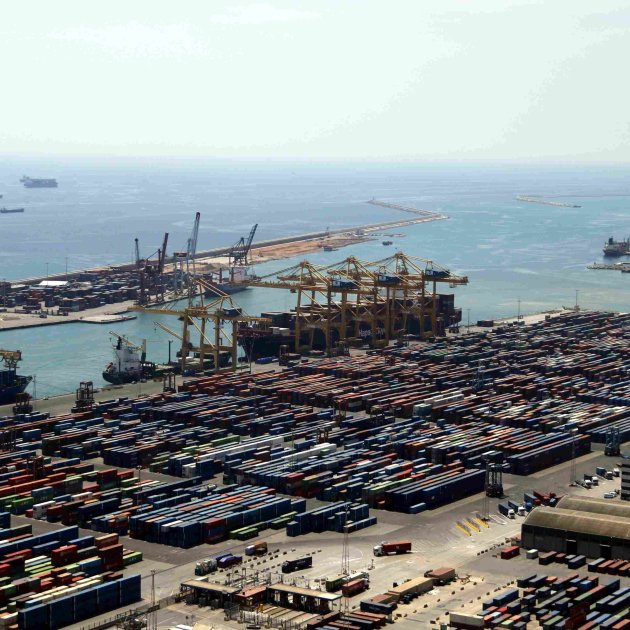The Catalan government is to install a floating desalination plant in the port of Barcelona, which will come into operation in the event that Catalonia's Ter-Llobregat catchment system enters the Emergency II phase of the drought, a scenario that is not expected before October. The port plan has been approved by the government's interdepartmental drought committee with the aim of guaranteeing water supply in Barcelona and its metropolitan area in the coming months without the need to apply new restrictions. The floating desalination plant will produce 14 hm³ annually, equivalent to 6% of the Barcelona metropolitan area's water usage. The installation will contribute 40,000 cubic metres of water to the distribution network and, with this operation, there will be no need to ship in water by tanker from outside Catalonia.
Phase II of the Emergency status, under the drought protocol, is declared when reserves go below 67 hm³ (10.95%) for the catchment. At that point, water consumption would be restricted to 180 litres per inhabitant per day, although this is not controlled individually, but rather at municipal level, and it also allows for economic and commercial activities within the municipality. Thus, when a town enters this phase, the total volume of water entering the municipal water supply reservoirs cannot exceed the sum of 180 litres per inhabitant, multiplied by its population. Among actions banned are washing vehicles except in commercial carwash facilities using recycled water, use of potable water for outdoor cleaning, watering of plants and gardens beyond "survival" watering (with regenerated or freatic water); filling of all swimming pools except those shared pools classified as "climate shelters" and those certified for therapeutic use or which use sea water; operation of ornamental fountains and other asthetic uses of water except fauna refuges, with regenerated or freatic water; use of beach showers. At present, this classification applies to some municipalities in Catalonia's northernmost coastal country, the Alt Empordà.
The port is ready
As explained by the Catalan climate action minister, David Mascort, the purchase of the desalination plant has been calculated based on a usage lifetime of five years. However, the minister has reiterated that, in the event that Barcelona and its metropolitan area do not need the water produced from the desalination plant, the Catalan government "could sell it". Mascort also indicated that the five-year forecast coincides with the period needed for other key infrastructure works related to water resources to be in place, such as the expansion of the Tordera and Foix desalination plants.
The floating desalination plant will generate 14hm³ annually, equivalent to 6% of the consumption of the metropolitan area of Barcelona. These types of installations are ships equipped with the elements and technology necessary to carry out desalination by reverse osmosis. The port of Barcelona already has some of the on-shore facilities ready and the point where the desalination plant will be located and the connection to the water network main has also been agreed. The water that is produced will be sent to an intermediate tank, currently being set up, which will be operational in June. From this tank, the water will be incorporated into the distribution network.
More efficient system than shipping
The volume of water that the new plant will enable to be added daily to the network is higher than what would have been brought to the system via ongoing shipping conveys, the alternative that was initially studied. The floating desalination plant produces around 40,000 m³/day, while ships could bring in an average of 25,000m³ per day.
As well, the cost of producing water through a floating desalination plant is much cheaper, almost half, than water shipped in. Thus the cost will be around €6/m³, while with ships it rises to €10/m³. The Generalitat has opted for this alternative to also avoid possible setbacks and delays that could have occurred with the use of boats.
On the other hand, a third factor is the amount of energy use involved: reverse osmosis is an energy-intensive process. Although shipments of fresh water also need significant energy input, either system effectively means that Catalan consumers are becoming more dependent on energy - including fossil fuel - just to meet their water needs.
Twelve desalination plants on the Costa Brava
As well as the Barcelona plan, the Catalan government and the Costa Brava-Girona water consortium (CACBG) will buy 12 mobile desalination plants to supply a dozen municipalities from June. Specifically, they are destined for areas in the Alt Empordà county, which are already in a Emergency II drought phase. According to the executive, four desalination plants will be installed in Roses, four at the Empuriabrava water treatment facilities and four more at Empuriabrava beach. The destination of the water produced at the Roses desalination plants will be the municipality itself, through a connection to the distribution network, while the rest of the desalination plants will provide service to the municipalities supplied by the ETAP Empuriabrava: Cadaqués, Llançà, Roses, Castelló d'Empúries - which includes Empuriabrava - Mancomunitat de Pau, Palau Saverdera, Vilajuïga, Garriguella, Pedret i Marzà, El Port de la Selva and Selva de Mar.
The 12 mobile desalination plants will have an approximate cost of 10 million euros and it is expected that each of them will produce 1,000 m³ a day, production that will cover approximately 35% of the water demand of the supply area of the northern Costa Brava, in the Costa Brava Girona water consortium (CACBG). This is the more complex part of the Costa Brava in terms of its water supply, with central areas connected to tthe Baix Ter catchment - that is to say, to the Sau and Susqueda reservoirs - and the southern parts of the coast supplied from the existing Tordera desalination plant and the Palafolls treatment plant.
